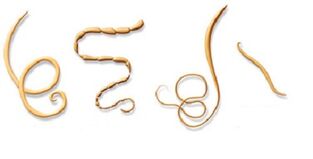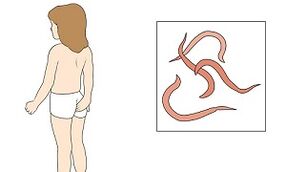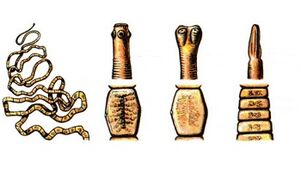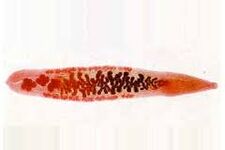Different types of parasites can be found in the human body for a very long time and cause very specific damage to health.
A significant number of people suffer from serious diseases caused by parasites. At the same time, many have no idea whether there are pests in the intestines and other organs.
Each species of parasite known to science has its own individual characteristics that an adult should be aware of.
Risk of infection

At present, science knows more than 200 types of parasites for which the human body is the habitat.
The ways and means of penetrating pests to the most favorable location have been examined in detail. We can say that each type of parasite has its own "specialization".
Many of the helminths live in the gastrointestinal tract. There are also those that parasitize the liver, lungs, and even the brain.
Almost everyone is exposed to parasitic attacks. It is also likely to be an adult or a breast-fed baby.
A great danger is the presence of parasites in children. This is particularly reflected in the state of health. Babies often get sick for no apparent reason.
The physical and mental development is delayed. It is not so easy to identify the cause of the malaise, although it is often "nearby".
It is enough to conduct certain studies, identify the type of parasite and prescribe a method of treatment.
A significant number of adults are at risk because their occupational activity involves processing raw materials contaminated with helminths.
Some types of parasites are very resistant to environmental influences and can be very difficult to destroy.
Pest types
The appearance of parasites in the human body is always accompanied by certain signs.
The peculiarity of this situation is that the symptoms are often very mild and it is difficult to determine the presence of pests without special studies.

The following types of helminths parasitize the body:
- round;
- tape;
- leeches.
This classification was made with external characteristics in mind, while parasites share many common characteristics regardless of species.
Hooks and suction cups of different shapes should make it easier for parasites to fix their position in a certain place.
The life cycle of many parasites consists of several phases. In addition, a kind of tapeworm has two "owners" - a male and a pet.
Closed-loop migration offers these pests the opportunity to exist and multiply. During movement, the parasite penetrates the human body and feeds on it.
This function is common to all microorganisms that live in the intestine or other organs. Only useful species are included in creative activity, and parasites are included in destructive activity.
Under these circumstances, humans must support what is useful and suppress pests.
roundworms
Ascaris is one of the roundworms. It is a parasite of orange color and without suckers.
The spindle shape enables it to wander through various organs and penetrate into the smallest openings and folds. This type of parasite can invade the lungs or pancreas.
The eggs laid by the roundworm are protected by a strong shell that withstands the destructive effects of hydrochloric acid in the stomach. Most often, people become infected with unwashed vegetables and fruits.
The pinworm also gets into the human body. In appearance, it is a thin striped worm of light gray color, growing up to 10 mm in length. The parasite begins to harm humans as early as the larval stage.

The larva develops into a sexually mature individual and secretes toxic enzymes that irritate the intestinal mucosa.
An adult pinworm can penetrate the deep layers of the small intestine and penetrate it through and through. In such situations, a serious disease called peritonitis develops.
Another round parasite that parasitizes the large intestine is the whipworm.
The following symptoms occur when ingested:
- headache and dizziness;
- persistent abdominal pain;
- sleep disorder.
Vlasoglav got its name from its external features - the worm is very thin and reaches a length of 50 mm. The parasite is the causative agent of trichocephalosis.
The body never leaves its limits - the worm can only be destroyed, whereupon the parasite comes out along with the feces.
tapeworms
The occurrence of parasites in humans follows similar scenarios. Pork and beef tapeworms in the form of tapeworms get into the body when they eat meat, pork and beef, which is contaminated by the Finns.
These fins or larvae are white blisters in appearance and resemble millet groats.
When they reach the intestine, the larvae entrench themselves and develop into a full-fledged parasite. In most cases the development is asymptomatic.
After about three months, the tapeworm can already produce offspring. This type of pest reaches a length of ten meters or more.
The presence of tapeworms in the body causes severe teniarhinosis. A more serious threat to human health is the ribbon-type parasite Echinococcus.

For this parasite the human body is a shelter. The main owners are animals - dogs and cats. People become infected through contact with their beloved animals through the digestive tract - through the mouth.
On reaching the intestine, the eggs begin to develop into larvae that have six hooks for fixation.
They are transported to various organs in the bloodstream and are mostly fixed in the liver and lungs.
Echinococcus begins to destroy the surrounding tissue in adulthood. Sometimes parasites large enough to be a tumor are thought to be.
Alveococcus is another representative of the ligament parasite in the human body. After entering the intestine, the larvae develop intensely and penetrate the walls of the small intestine and are transported by the bloodstream to various organs and systems.
Like Echinococcus, the parasite is fixed in the liver and begins its destructive activity.
Alveococcus has the shape of a multi-chambered bladder called a larvocyst. These larvocysts can invade the liver tissue and develop into cancer-like metastases.
The blood supply to the liver tissue is cut off, necrosis begins, which poses a serious threat to human health and even life.
Fluke Worms
The list of tapeworms contains a separate species of parasite called Flukes.
The following species are particularly dangerous leeches:
- Cat coincidence;
- Fasciola;
- schistosome.

Liver diseases occur more frequently in human diseases than in other organ diseases. The leeches got their name because of their anatomical structure.
There are several suction cups on the body of the parasite, with the help of which the pest is held in a certain place and penetrates deep into living tissue.
Feline fluke is most common in the gallbladder and pancreatic duct.
Fluke enters the human body with fish that have not been sufficiently salted or cooked.
In people affected by this pest, the temperature rises sharply, an unreasonable cough occurs, and rashes appear on the body. If you don't take immediate action, the person can die.
Fasciola is absorbed by the body by drinking uncooked water. With the patient's consent, it causes chronic jaundice.
Schistosomiasis, which is caused by a rare parasite, has become more common in recent years.
This fact is explained by the fact that a large number of people began to visit tropical countries where this pest is widespread.
Preventive measures
Medical practice shows that parasites take root in the intestine much more often than in other organs.
Pests of various species can adapt to exist in the liver, lungs, heart, brain and even in the eyes - only this listing gives a sufficient overview of the danger that parasites pose to human health and full life.

Different types of parasites can enter the body both individually and in combination, which increases the severity of the lesion.
To prevent pests of any kind in your body, it is enough to follow the basic rules of hygiene and the rules of hygiene for food.
Young children should be kept under constant supervision, especially in the summer when they go to the land or seaside.
Today there is no need to eat raw meat or fish, including stroganin. This atavism should stay in the past forever so as not to expose your body to unnecessary risks.
















































